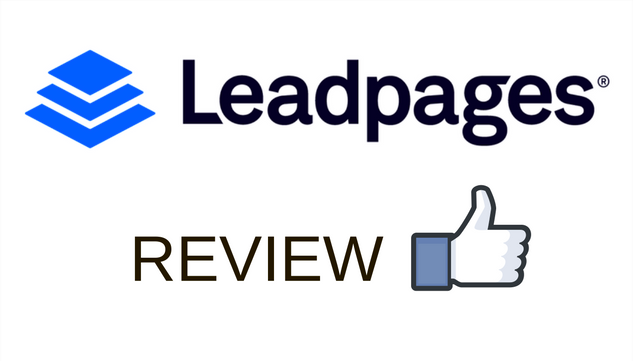
Fake reviews are becoming hard to spot. This is a problem because over 70% of Americans read reviews before buying an item — no doubt, reviews influence buying decisions.
With more people buying online due to the coronavirus, reviews have become even more powerful. Savvy merchants are doing more than seeking more reviews, they prioritize authenticity.
Luckily you can cut through the review noise; thanks to Amazon’s Verified Purchase label.
But there’s more:
Using tools like Fakespot, you can spot fake reviews across marketplaces. You can even catch fakes from verified Amazon purchases.
Fakespot is a leading tool in this space. This tool checks reviewers and reviews to determine their legitimacy.
But, Fakespot is not the only tool that spots fake reviews — you have alternatives.
As the headline goes, we will explore the best alternatives to Fakespot in this post. We will also compare these tools, feature by feature.
Let’s get to it.
Best Fakespot Alternatives
1. ReviewMeta
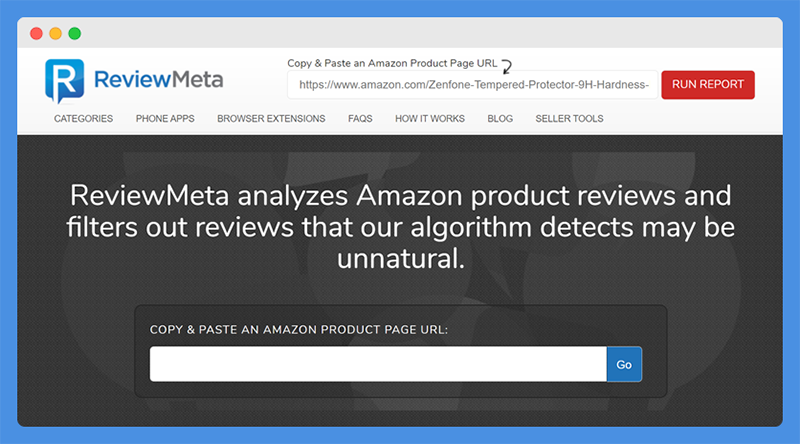
The first Fakespot alternative on our list is ReviewMeta.
ReviewMeta is an Amazon-only analyzer that simplifies the grading of reviews.
Most ReviewMeta features are similar to Fakespot. It allows you to copy and paste a page’s URL. Instead of handing out the page’s grade, this tool gets rid of reviews it sees as unreliable. ReviewMeta then replaces Amazon’s aggregate rating with its own.
ReviewMeta also allows you to tweak its algorithm. You can change how categories are weighted in the grading mechanics after the tool analyzes a webpage.
This tool also gives you detailed breakdowns, including graphs, to show factors causing the adjusted ratings.
2. TheReviewIndex

TheReviewIndex is another alternative to Fakespot you can use.
TheReviewIndex focuses on curating tech ratings on Steam and Amazon. Even better, the tool determines if fake reviews influence a product’s score.
With this tool, you also paste the URL on the platform. The platform then breaks down the product into different categories depending on the words analyzed from the reviews.
TheReviewIndex also runs a spam test to check the authenticity of reviews and provides a grade after analysis.
Fakespot Vs ReviewMeta Vs TheReviewIndex
Let’s do a quick comparison of these tools along with Fakespot. We’ll see how these tools fare when put side by side.
Review Analysis
With review checkers, it’s important to know how they analyze reviews.
Fakespot
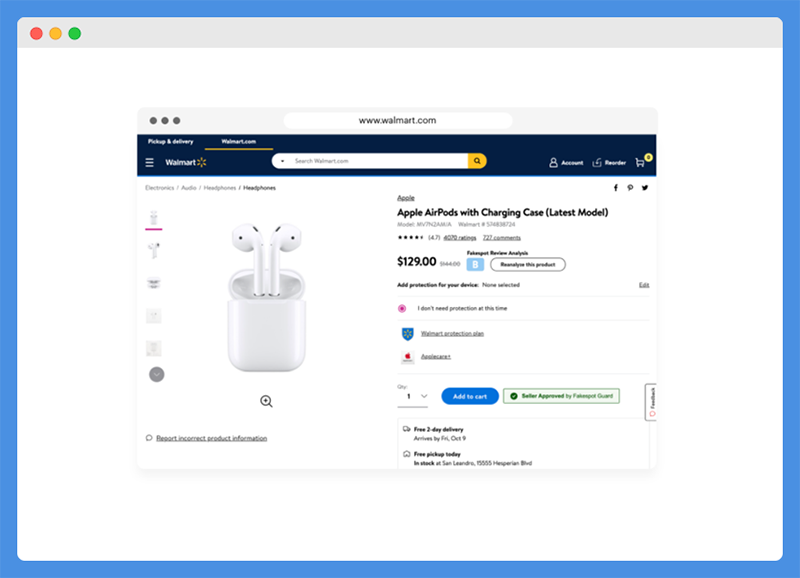
Fakespot uses a consumer-first approach to integrate its review analysis. This gives you a better shopping experience on their supported websites.
The tool analyzes reviewers and reviews — checking for metrics like:
- Mismatched dates
- Number of reviews
- Questionable grammar and spelling
- Other signs of suspicious review activities
Once the tool is done with its analysis, it grades reviews using letters. These grades depend on the total number of reviews and those that are suspicious. The tool uses letters like:
- A & B for reliable reviews
- C for a mix of reliable and unreliable reviews
- D & F for insufficient reliable reviews
ReviewMeta
ReviewMeta gathers publicly available reviews for your preferred product. The tool also looks at the reviewers behind the reviews it gathers.
Also, ReviewMeta automatically checks the available data and gives you an overview of what’s happening.
Once the tool gathers all the data on a product, it performs analysis and runs different tests. They use statistical modeling on suspicious reviews to ensure they are not a result of random chance.
ReviewMeta checks to see if discrepancies are statistically substantial or not. The tool also factors in the sample size and distribution and controls these variables to ensure accuracy in the tests.
The tool also presents results in an easy-to-understand format. Also, reviews are graded using a pass, warn, and fail mark.
ReviewMeta also shows you the top least trusted and most trusted reviews.
The tool also goes in-depth and identifies patterns in the reviews. They also provide links to examples and reasons why they think the reviews are suspicious.
TheReviewIndex
TheReviewIndex gathers data like reviews and product details. The tool then crawls through the available data from multiple public webpages.
Also, the tool churns this data to produce interpretable insights, including graphs.
Verdict
ReviewMeta wins this one. The tool runs multiple tests and uses statistical modeling to ensure the accuracy of its results. Plus, you’re presented with in-depth insights into the reviews.
Review Summary
How these review analysis tools present results from their analysis is important. Let’s see how these tools do it.
Fakespot
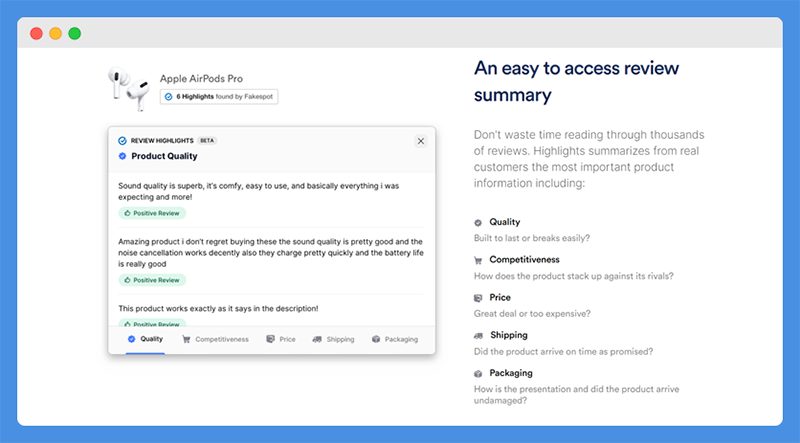
Fakespot has a “Highlight” feature that summarizes important product details from real customers. The tool provides information on:
- Price
- Quality
- Competitiveness
- Packaging
- Shipping
ReviewMeta
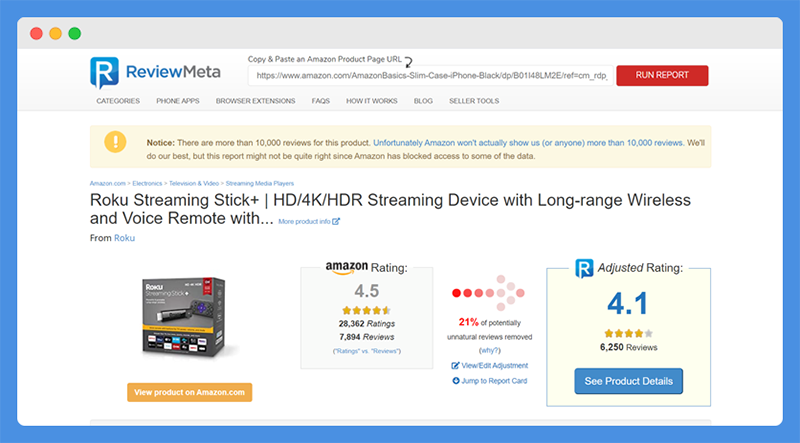
After analyzing a page, ReviewMeta allows you to adjust how categories are weighted from the grading mechanics. The tool also gives you a detailed breakdown of the factors affecting the adjusted rating.
TheReviewIndex
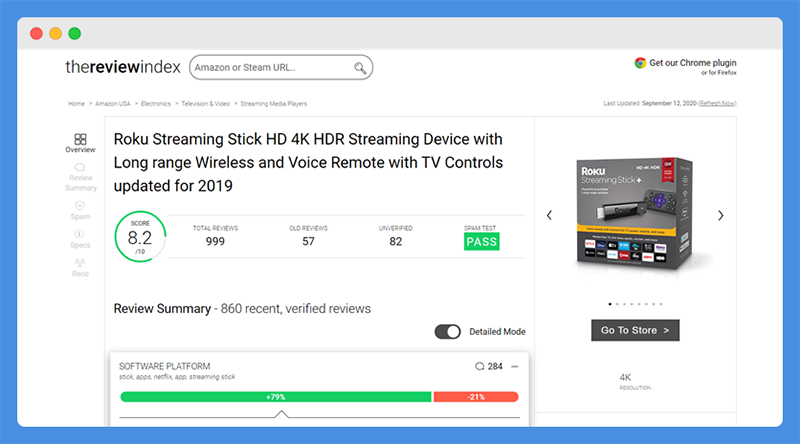
After pasting a URL on TheReviewIndex, the tool categorizes products depending on words gotten from reviews. The tool also uses a Pass or Fail grading format after running a spam test to check the authenticity of reviews.
Verdict
Fakespot wins here. The tool offers a highlight feature that breaks down products into different categories based on the reviews.
Adjusted Rating
Adjusted rating helps you cut through biased reviews to see how the average rating looks like. Let’s see if these tools offer this feature.
Fakespot
Fakespot does not offer this feature.
ReviewMeta
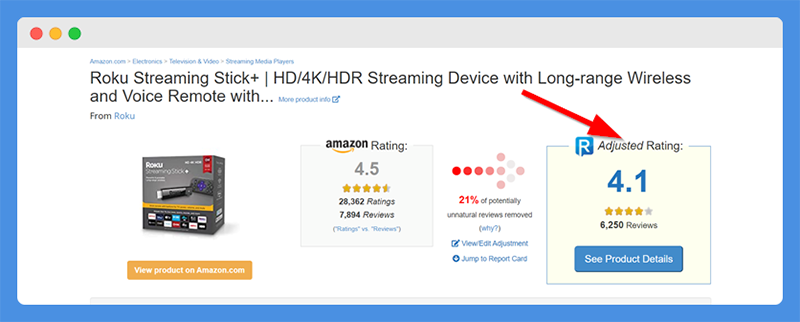
ReviewMeta filters suspicious reviews and recalculates the average ratings. The tool then shows you these average ratings at the top of every report.
ReviewMeta also used the adjusted rating feature to give an overall analysis result of products. An original rating with a lower adjusted rating can mean a “failing grade.”
TheReviewIndex
TheReviewIndex doesn’t support this feature.
Verdict
ReviewMeta is the obvious winner for this round. You can see adjusted ratings for a detailed analysis of products.
Browser Extension
Browser extensions make it easy to access review checkers. Let’s see the extensions these tools offer.
Fakespot

Fakespot has a Chrome extension that lets you analyze a webpage without switching tabs.
ReviewMeta
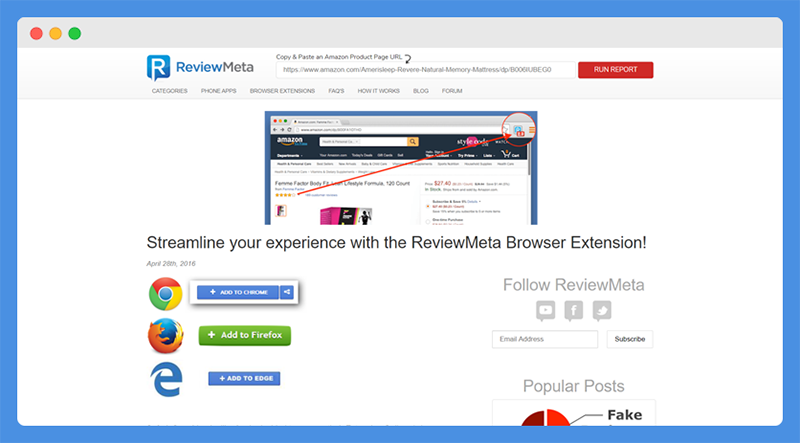
ReviewMeta provides browser extensions for Edge, Firefox, and Chrome. You can quickly analyze web pages and get a Fail, Pass, or Warn grade based on the results.
This tool has a Bookmarklet feature that serves as an alternative to its browser extension. The Bookmarklet automatically checks the Amazon product page you’re on and opens a result on the ReviewMeta platform.
More so, the Bookmarklet works on multiple platforms and devices.
TheReviewIndex
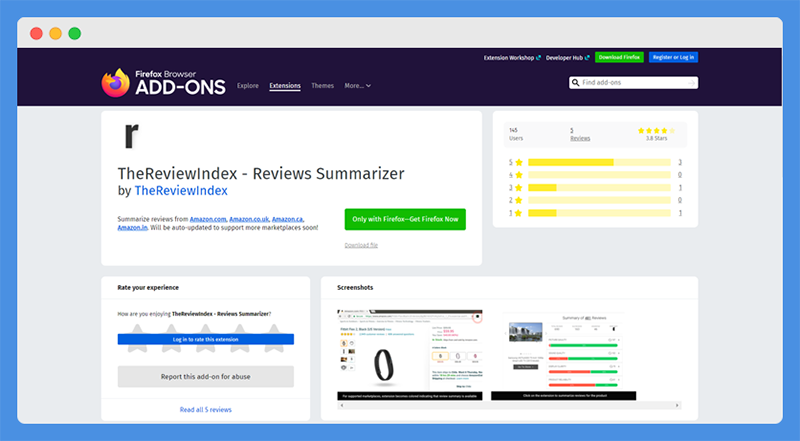
TheReviewIndex has a browser extension for Firefox and Chrome.
Verdict
ReviewMeta wins again. The tool has extensions for different browsers. Plus, it has an alternative to its browser extension that works on different platforms and devices.
Personalization
Being able to customize settings to fit your taste is also an important feature.
Fakespot
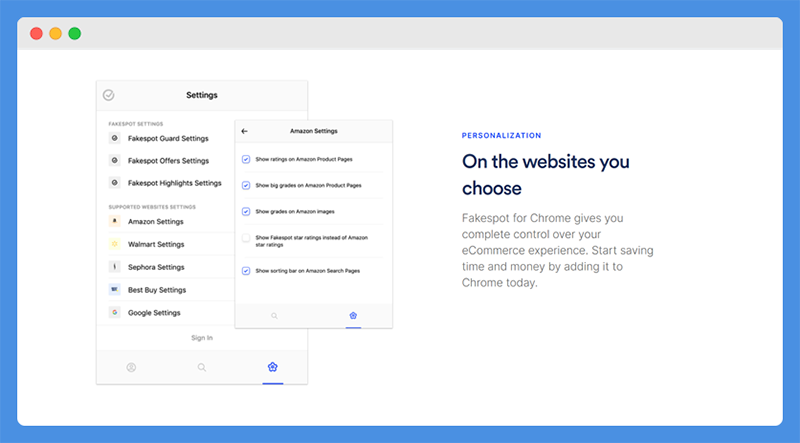
With Fakespot’s Chrome extension, you have complete control of your shopping experience. The tool allows you to change settings for individual supported websites. You can also change what the tool shows or doesn’t show.
ReviewMeta
ReviewMeta does not offer any personalization options.
TheReviewIndex
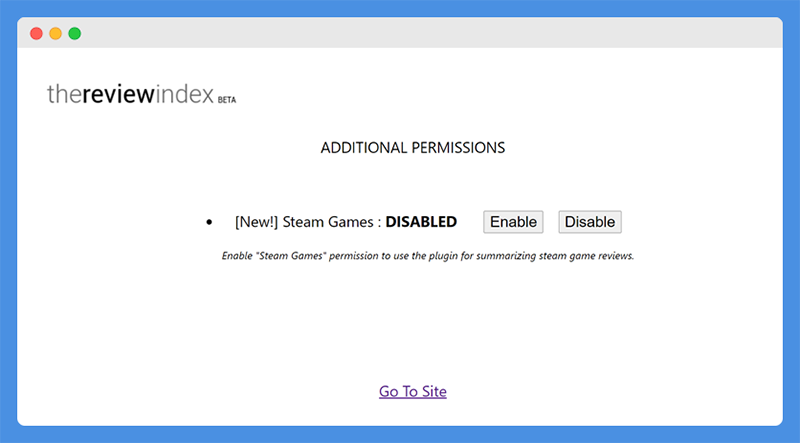
TheReviewIndex also doesn’t offer any personalization options. But, with the tool’s extension, you can choose to enable “Steam Games” permission. This allows the plugin to summarize steam game reviews.
Verdict
Fakespot wins this round. You can change the settings in the tool’s extension to fit your preference.
Pricing Analysis
Let’s see if these tools also analyze prices on eCommerce stores.
Fakespot
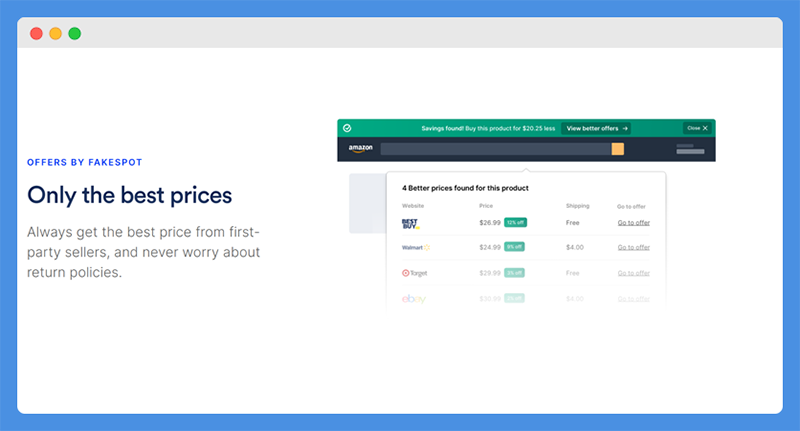
Aside from analyzing reviews, Fakespot also provides you with the top prices from first-party sellers. The tool also takes care of return policies.
ReviewMeta
ReviewMeta doesn’t analyze the prices of products.
TheReviewIndex
This tool doesn’t have this feature.
Verdict
Fakespot is the winner here. You have access to the best prices from first-party sellers.
Seller Analysis
Let’s see if these tools take it further by analyzing sellers.
Fakespot
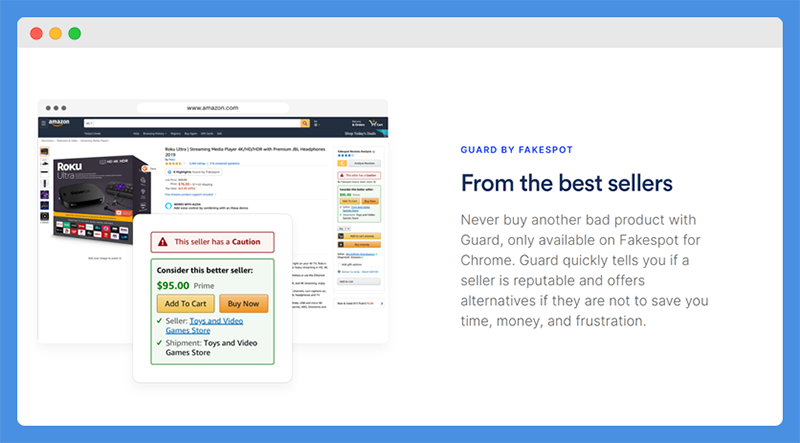
Fakespot has a “Guard” feature available on its Chrome extension. Fakespot’s Guard tells you if sellers are reputable. The tool also provides alternatives for sellers that seem untrustworthy.
ReviewMeta
This tool does not support this feature.
TheReviewIndex
TheReviewIndex does not perform seller analysis.
Verdict
Fakespot also wins here. With its Guard feature, you have access to reputable sellers.
Marketplace Presence
Here, we’ll talk about the eCommerce stores that these tools work on.
Fakespot
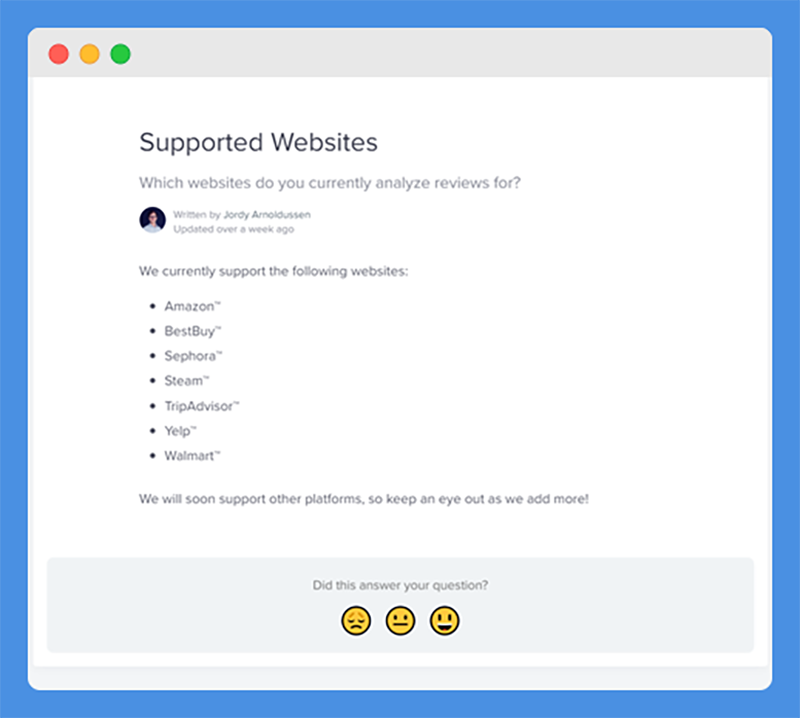
Fakespot supports websites like:
- Amazon.com
- Amazon UK
- Amazon Canada
- Amazon Australia
- Amazon India
- Walmart
- Yelp
- TripAdvisor
- Steam
- Sephora
- BestBuy
ReviewMeta
ReviewMeta works on:
- Bodybuilding.com
- Amazon.com
- Amazon Canada
- Amazon UK
- Amazon Australia
- Amazon France
- Amazon Italy
- Amazon Deutschland
TheReviewIndex
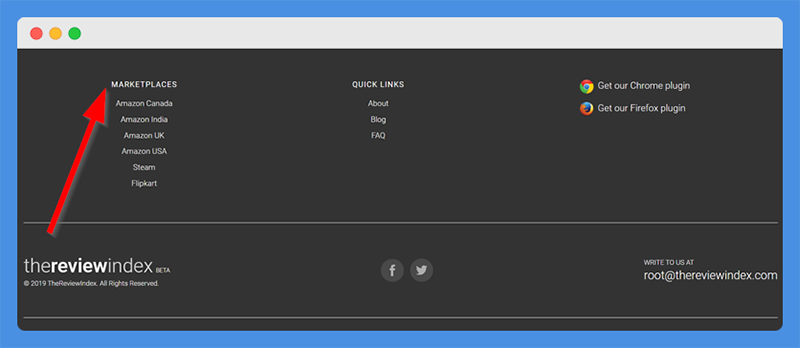
TheReviewIndex supports marketplaces like:
- Flipkart
- Steam
- Amazon Canada
- Amazon USA
- Amazon UK
- Amazon India
Verdict
Fakespot wins this round. The tool supports more marketplaces than TheReviewIndex and ReviewMeta.
User Experience
It’s important to know how easy these tools are to use. Let’s see what the user experience on these tools is like.
Fakespot
Fakespot has an easy-to-use interface. After installing the tool’s browser extension, you can choose what you’re shown. This gives you access to Fakespot’s Analyzer bar.
Even more, the tool notifies you where there’s a better product, great prices, and even bad sellers.
ReviewMeta
ReviewMeta’s homepage has a search bar at the top. You can copy and paste a product URL into the search bar for the tool to analyze. It’s pretty straightforward.
TheReviewIndex
TheReviewIndex is similar to ReviewMeta. You need to enter the product URL in the tool’s search bar. This allows TheReviewIndex to fetch user reviews from their supported sites.
The tool removes unnatural content and parses the reviews to check for sentiments and fine-grained topics. This gives users access to churned information in the form of a summarized scorecard.
TheReviewIndex homepage also has different product categories that it caters to. These categories include speakers, televisions, mobile phones, and so on.
Clicking any of these categories takes you to a list of items in that category.
Mobile Apps
Let’s see if these tools are available on mobile devices.
Fakespot
Fakespot is available as a mobile app for Android and iOS devices. You can share web pages directly to the app for analysis from a browser.
With iOS devices, you need to set up action buttons. But, with Android devices, you can start using Fakespot’s Analyzer from your browser on any of their supported websites and their apps.
ReviewMeta
ReviewMeta has an app for Android and iOS devices. You can browse Amazon on your phone and share pages with the ReviewMeta app, which analyzes the product’s reviews.
TheReviewIndex
TheReviewIndex does not support mobile applications.
Use of Artificial Intelligence
Let’s see if these tools use AI or some other method to analyze reviews.
Fakespot
Fakespot uses AI in its Highlights feature to pick on patterns. As more data flows into the system, the system gets better at identifying unreliable and fake content.
The tool’s algorithm also runs through different tests to check the authenticity of reviews.
ReviewMeta
Instead of AI, ReviewMeta uses an analyzer to run through data. Also, the analyzer uses statistical modeling to check for discrepancies in reviews.
TheReviewIndex
TheReviewIndex does not use AI in its analysis. Instead, the tool leverages Neural Networks to identify sentiments and topics of discussion in reviews. The tool also monitors data and algorithm quality to ensure accuracy and stop outliers from influencing the results.
Verdict
Fakespot wins this one too. The tool uses AI to analyze review data.
Languages Supported
Let’s go through the languages supported by these tools.
Fakespot
Fakespot supports only English.
ReviewMeta
ReviewMeta supports English, Japanese, Portuguese, Italian, Spanish, Deutsche, and French.
TheReviewIndex
TheReviewIndex only supports English.
Verdict
ReviewMeta is the winner here. The tool supports multiple languages.
API Support
Let’s check if these tools offer any API support.
Fakespot
Fakespot does not support this feature.
ReviewMeta
ReviewMeta has a simple API that lets you get information on any report.
All you need to do is add “/api” after the tool’s domain name in any of their URLs. The tool displays information with different variables like:
- Count for the adjusted review count
- Rating for the adjusted rating
- S_overall to identify whether the review has a pass, fail, or warn mark
- Href to view full reports on ReviewMeta
TheReviewIndex
This tool does not support this feature.
Verdict
ReviewMeta is the winner here. The tool’s API allows you to retrieve data about reports.
Customer Service & Support
Every now and then, you might hit a snag with these tools. Let’s see the support options they offer.
Fakespot

Fakespot offers support via a contact form. After filling the form, a member of the Fakespot support team will get in touch with you.
The tool also has a FAQ section with different helpful articles. Plus, there’s a blog with a wide array of useful articles.
ReviewMeta
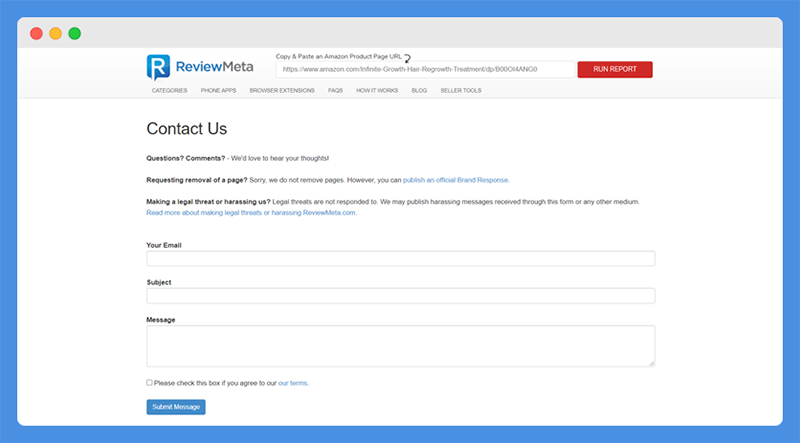
ReviewMeta also offers support via a contact form. You can use this form to ask questions or leave comments.
Also, ReviewMeta has a FAQ page with useful information on using the platform. The tool even has a blog page with relevant articles.
TheReviewIndex
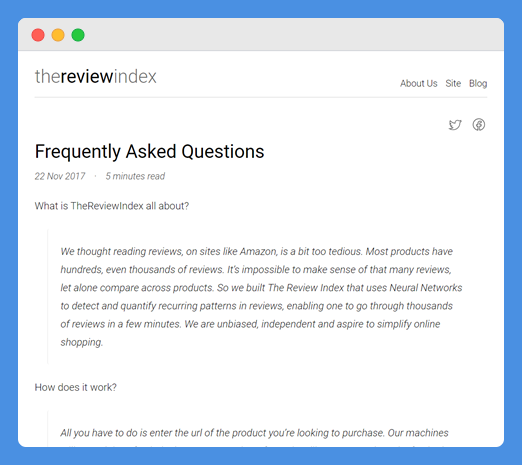
TheReviewIndex offers support via email. The tool also has a FAQ section and blog page with relevant resources and articles.
Verdict
All three tools win this one. They offer support via mail or contact form. Plus, they all have a FAQ section and a blog page.
Pricing
All three tools can be downloaded for free. Hence, no evaluation in terms of price.
Similarities
These tools have some features in common. Let’s have a look.
- Fakepsot, ReviewMeta, and TheReviewIndex are all free.
- All three tools have browser extensions.
- They all analyze reviews on multiple marketplaces.
Differences
Let’s discuss the features that set these tools apart.
Advantages
Let’s take a look at the benefits of these review checkers.
Fakespot
- Fakespot has an easy-to-use interface
- You have access to the top prices from first-party sellers
- The tool is free
- Fakespot has a Chrome extension
ReviewMeta
- ReviewMeta is free
- The tool supports adjusted ratings
- You have access to an API for information on reviews from the platform
TheReviewIndex
- You can download the tool for free
- The tool supports other marketplaces asides from Amazon
Disadvantages
No tool is perfect and these tools are not excluded. They have their own disadvantages.
Fakespot
- Evaluation algorithm can be inaccurate sometimes
- The tool only supports English
- Fakespot doesn’t support any API
ReviewMeta
- ReviewMeta does not offer any customization options
TheReviewIndex
- The tool supports only English
- TheReviewIndex doesn’t support any mobile app
Final Thoughts: What’s The Best FakeSpot Alternative
So, we’ve been able to look at some Fakespot alternatives. We also compared them side by side with Fakespot itself.
These tools come with their unique features, but we need to pick a winner — ReviewMeta.
ReviewMeta is a free tool that helps you analyze reviews and decides which ones are trustworthy. It is also easy-to-use — simply copy and paste a product URL into the tool’s search bar for analysis.
The tool has a browser extension for Chrome and Firefox, which helps you streamline the research process. Plus, you are provided with adjusted ratings for products depending on trustworthy reviews.
ReviewMeta also runs multiple tests to check for suspicious traits. The tool offers Pass, Warn, or Fail grades and adjusts ratings on supported sites.

